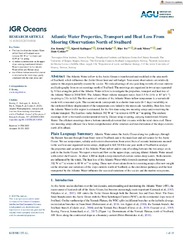Atlantic water properties, transport and heat loss from mooring observations north of Svalbard
Permanent link
https://hdl.handle.net/10037/26777Date
2022-08-05Type
Journal articleTidsskriftartikkel
Peer reviewed
Author
Koenig, Zoe Charlotte; Kalhagen, Kjersti; Kolås, Eivind Hugaas; Fer, Ilker; Nilsen, Frank; Cottier, FinloAbstract
The Atlantic Water inflow to the Arctic Ocean is transformed and modified in the area north
of Svalbard, which influences the Arctic Ocean heat and salt budget. Year-round observations are relatively
sparse in this region partially covered by sea ice. We took advantage of one-year-long records of ocean currents
and hydrography from seven moorings north of Svalbard. The moorings are organized in two arrays separated
by 94 km along the path of the Atlantic Water inflow to investigate the properties, transport and heat loss of
the Atlantic Water in 2018/2019. The Atlantic Water volume transport varies from 0.5 Sv (1 Sv = 106
m3
s−1)
in spring to 2 Sv in fall. The first mode of variation of the Atlantic Water inflow temperature is a warm/cold
mode with a seasonal cycle. The second mode corresponds to a shorter time scale (6–7 days) variability in
the onshore/offshore displacement of the temperature core linked to the mesoscale variability. Heat loss from
the Atlantic Water in this region is estimated, for the first time using two mooring arrays and conserving the
volume transport. The heat loss varies between 302 W m−2 in winter to 60 W m−2 in spring. The onshore
moorings show a westward countercurrent driven by Ekman setup in spring, carrying transformed-Atlantic
Water. The offshore moorings show a bottom-intensified current that covaries with the wind stress curl. These
two mooring arrays allowed for a better comprehension of the structure and transformation of the slope currents
north of Svalbard.
Publisher
WileyCitation
Koenig ZC, Kalhagen K, Kolås E, Fer I, Nilsen F, Cottier F. Atlantic water properties, transport and heat loss from mooring observations north of Svalbard. Journal of Geophysical Research (JGR): Oceans. 2022;127(8)Metadata
Show full item recordCollections
Copyright 2022 The Author(s)


 English
English norsk
norsk